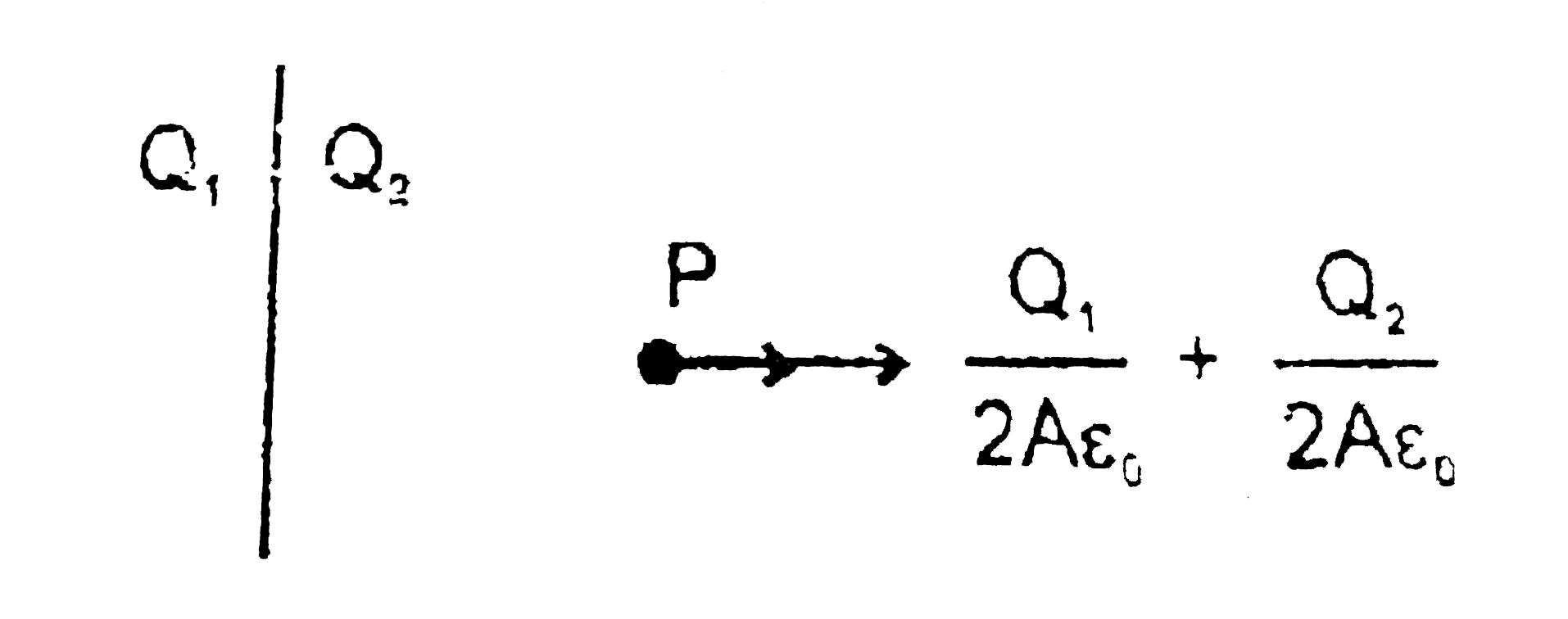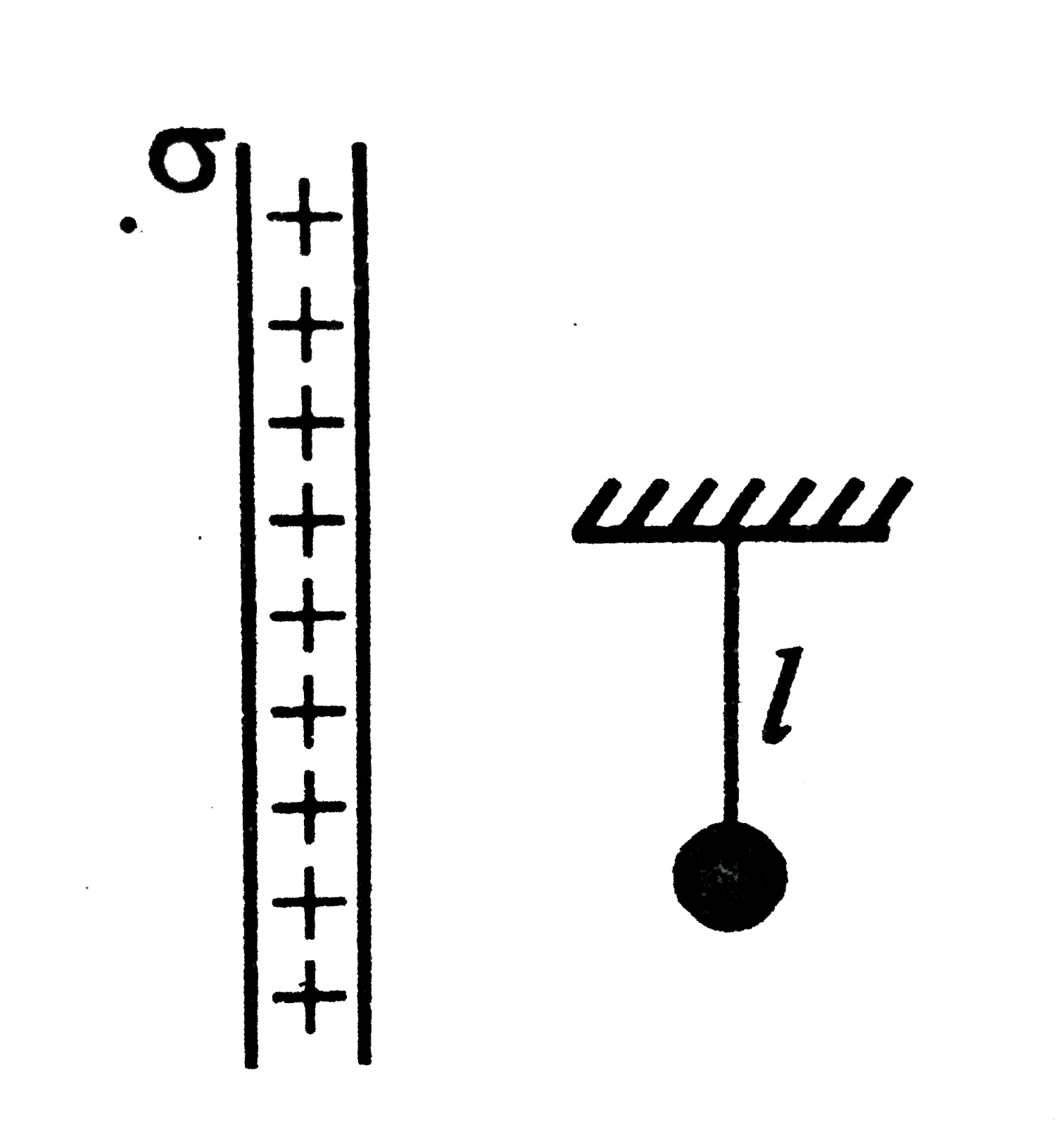If an isolated infinite plate contains a charge Q1 on one of its surfaces and a charge Q2 on its other surface, then prove that electric field intensity at a point in front of the plate will be Q/2Aε0, where Q=Q1+Q2Solution in Gujrati
Electric field at point P : →E=→EQ1+→EQ2=Q12Aε0ˆn+Q22Aε0ˆn=Q1+Q22Aε0ˆn=Q2Aε0ˆn

[This shows that the resultant field due to a sheet depends only on the total charge of the sheet and not on the distribution of charge on individual surfaces].
Topper's Solved these Questions
- MISCELLANEOUSBOOK - ALLEN CHAPTER - MISCELLANEOUSEXERCISE - Part -II Example Some worked out Examples
1 Videos
- MISCELLANEOUSBOOK - ALLEN CHAPTER - MISCELLANEOUSEXERCISE - Exercise-01
87 Videos
- MISCELLANEOUSBOOK - ALLEN CHAPTER - MISCELLANEOUSEXERCISE - Question
1 Videos
- KINEMATICS (MOTION ALONG A STRAIGHT LINE AND MOTION IN A PLANE)BOOK - ALLEN CHAPTER - KINEMATICS (MOTION ALONG A STRAIGHT LINE AND MOTION IN A PLANE)EXERCISE - BEGINNER S BOX-7
8 Videos
- PHYSICAL WORLD, UNITS AND DIMENSIONS & ERRORS IN MEASUREMENT BOOK - ALLEN CHAPTER - PHYSICAL WORLD, UNITS AND DIMENSIONS & ERRORS IN MEASUREMENT EXERCISE - EXERCISE-IV
7 Videos
Similar Questions
For spherically symmetrical charge distribution, electric field at a distance r from the centre of sphere is →E=kr7→r, where k is a constant. What will be the volume charge density at a distance r from the centre of sphere?
View SolutionA stone is dropped into a quiet lake and waves move in circles speading out radially at the speed of 5 cm/s. At the instant when the radius of the circular wave is 8cm, how fast is the enclosed area increasing?
View SolutionA simple pendulum of length l and bob mass m is hanging in front of a large nonconducting sheet having surface charge density σ. If suddenly a charge +q is given to the bob & it is released from the position shown in figure. Find the maximum angle through which the string is deflected from vertical .
 .
.
View SolutionA football player kicks a ball at an angle of 30∘ with an initial speed of 20 m/s. Assuming that the ball travels in a vertical plane, calculate (a) the time at which the ball reaches the highest point (b) the maximum height reached (c) the horizontal range of the ball (d) the time for which the ball is in the air, (g=10m/s2)
View SolutionAssertion : Gravitational forces do not depend on the medium between the masses.
Reason : Mediating particle responsible for gravitational force is graviton.
View SolutionTwo conducting plates A and B are placed parallel to each other. A is given a charge. Q1 and B a charge Q2. Find the distribution of charges on the four surface.
View SolutionSuppose a charge +Q1 is given to the positive plates and a charge −Q2 to the negative plate of a capacitor. What is the "charge on the capacitor"?
View SolutionIf an isolated infinite plate contains a charge Q1 on one of its surfaces and a charge Q2 on its other surface, then prove that electric field intensity at a point in front of the plate will be Q/2Aε0, where Q=Q1+Q2
View SolutionIf an isollated infinite sheet contains charge Q_(1) on its one surface and charge Q_(2) on its other surface, then prove that electric field intensity at a point in front of sheet will be Q/(2A epsi_(0)) , where Q=Q_(1)+Q_(2)
View SolutionTwo identical metal plates are positively charged to Q_1" and " Q_2(Q_2 lt Q_1) . If they are brough near each other to form a parallel plate capacitor of capacitance C, then what will be the potential differences between the plates?
View SolutionC1 तथा C2 धारिता के दो संधारित्रों के समांतर संयोजन को Q आवेश दिया जाता है C1 पर Q1 ,C2 पर Q2 आवेश होने पर Q1Q2 का अनुपात होगा---
View Solutionदो एक जैसी धात्विक प्लेटों को क्रमशः q1 और q2 आवेश (q2<q1) दिया गया है। यदि ये दोनों प्लेटें आपस में पास लाकर एक समान्तर प्लेट संधारित्र की धारिता C है, बनाया जाये, तो इन प्लेटों के मध्य विभवान्तर ज्ञात कीजिए।
View SolutionTwo point charges q_1 and q_2 are fixed at a separation of 20 cm. Locate the point(s) on the line joining the charges where the net electric field intensity is zero. (i) q_1=+2muC and q_2=-4 muC (ii) q_1=+2muC and q_2=-2muC (iii) q_1=+2muC and q_2=+4muC
View SolutionTwo conducting plates A and B are placed parallel to each other. A is given a charge. Q1 and B a charge Q2. Find the distribution of charges on the four surface.
View SolutionSuppose a charge +Q1 is given to the positive plates and a charge −Q2 to the negative plate of a capacitor. What is the "charge on the capacitor"?
View Solution
